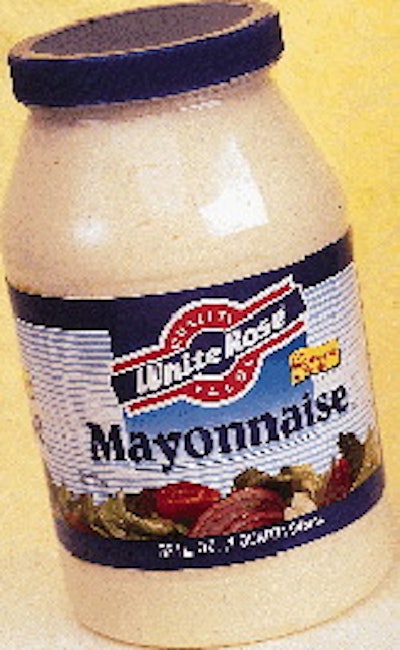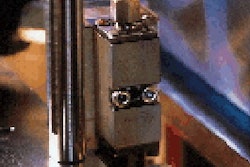Glass jars topped with metal lids have for years contained mayonnaise sold at retail. But supermarket shelves are now beginning to alot space for mayonnaise in wide-mouth plastic jars made of polyethylene terephthalate (PET).
Purportedly, economic and shelf life concerns have left PET out of the running for mayonnaise containers in the 32-oz and smaller sizes commonly sold by supermarkets. Many manufacturers and retailers, we're told, believed that glass topped with metal most effectively prevented oxygen ingression. That's important because oxygen can discolor mayonnaise and nullify its sales appeal. To provide sufficient oxygen barrier, it was believed that a PET container would have to be so heavy that its cost couldn't be competitive with glass in these sizes. But those beliefs may change.
At least three companies report that they're packing mayonnaise into PET bottles in sizes of 32-oz and smaller. Two of these are based in the U.S., national private-label manufacturer Martin Gillet, Baltimore, MD, and regional Carteret, NJ, grocery wholesaler White Rose Food Corp. Mayonnaise offerings from these companies are both filled at ambient temperatures. The combination of calcium disodium EDTA as a preservative/flavor enhancer, and the natural acidic quality of vinegar in mayonnaise combat bacterial growth. Both companies report that they had used the preservatives with previous glass jars as well and did not have to make product formulation changes to accommodate PET.
A third mayonnaise manufacturer to switch to PET for these smaller retail sizes is O. Kavli AB in Stockholm, Sweden (see sidebar, opposite page).
None of these three jars should be confused with existing plastic containers for this product: 10- or 12-oz tapered containers that enable consumers to squeeze out product through a dispensing fitment, nor the institutional, #10 sizes sold by some retailers. The new jars use the venerable wide mouth that provides consumers with easy access to the product with a knife or spoon.
Follow the leader?
When it comes to product/package introductions, smaller mayonnaise manufacturers usually follow the lead of national market leaders Bestfoods (formerly CPC Intl.) and Kraft Foods, according to sources we interviewed for this story. Smaller manufacturers can't match national brand companies in staff, facilities or investment dollars for product/packaging R&D. That's why they tend to emulate what sells for those national brands (see sidebar, page 25).
The precursor to these new PET bottles may well be Northfield, IL-based Kraft's 48- and 60-oz rectangular, wide-mouth PET mayonnaise containers that have been sold nationwide since 1990 and '93, respectively. Why was Kraft able to pack mayonnaise in PET so long ago? When asked, the company declined to comment on container economics. Nor would the company say why its 32-oz size remains in glass jars.
This time Martin Gillet and White Rose didn't wait for the national brands to make the first move. Instead, they took the lead, working with a supplier to iron out bottle economics and shelf life concerns.
Both Martin Gillet and White Rose are working with Grafco PET Packaging Technologies (Hanover, MD) as part of a "joint study" (see sidebar, page 24). Grafco tells Packaging World the study involves at least 10 manufacturers. Martin Gillet and White Rose use a 38-g jar with a 70/400 injection-molded polypropylene closure from Phoenix Closures (Naperville, IL), which partnered with Grafco in the study.
Reduces breakage
Dan McKernan, a White Rose product manager, describes the company as "the largest grocery wholesaler in the metropolitan New York area. We service about 1겨 stores, mainly in New York, but anywhere from Southern Connecticut to Philadelphia," he says. "We have three separate warehouses for grocery products, dairy/deli and frozen foods-everything but produce." The company uses contract packagers to fill products under its White Rose name and for store brands.
White Rose had used glass jars with metal lids until this spring. "Our contract packer said that it was considering becoming part of the test with Grafco to determine if PET would be suitable for mayonnaise," McKernan recalls. "And we wanted to be a part of that study because if [PET] was going to be the future, we wanted to be first." The CP refused to be identified or answer questions.
Besides "being the first," the PET jar for 32-oz White Rose-brand mayonnaise offers more tangible benefits, McKernan says. "The primary advantage is that it reduces breakage at the store level. That was a problem. Mayonnaise and ketchup in glass have been notorious for damage. The PET jar is also cheaper" than glass, he says, though he couldn't provide comparative figures. Shelf life, he indicates, is about 17 months, compared to 18 for glass.
"The product's only been out since about June, but so far the responses we've had have been positive," he notes.
Overseas now, U.S. next?
Like White Rose, Martin Gillet is optimistic about using PET for mayonnaise. "The expectation is that relatively soon the major mayonnaise brands will likely convert to PET from glass. We wanted to make sure that we were positioned so that we could enter the market with our own PET container," says George Petrie, senior vice president for manufacturing and operations for the custom maker of mayonnaise, dressings, sauces and specialty food products. The company primarily produces private-label products for both retail and foodservice markets.
"We've always sold mayonnaise in a glass jar with a metal lid," he contends. "We had seen the larger Kraft containers at club stores, and PET seemed to make sense from a weight standpoint." Petrie recalls that Martin Gillet was approached early last year to join the study.
Early this year, Martin Gillet began to ship PET-packed mayonnaise overseas. The company wouldn't identify what country or the particular brand name for the export. Petrie says Martin Gillet initially shipped one sea-going container. "It was so well-received that additional orders were placed."
As for the domestic market, the company still sells its Martin Gillet-brand 32-oz mayonnaise only in glass. Petrie says "we've had discussions with some of our private-label customers about PET, and they're very enthused about it. I would think that by early next year, we'll [have a customer] out in the market with mayonnaise in PET." He says that's likely to be a private-label customer, as Martin Gillet-branded mayonnaise is distributed on a more limited basis.
PET 'makes sense'
According to Petrie, PET offers a bevy of advantages. "For us, a case of PET-packed bottles provides about a twenty-percent weight savings in shipping compared to glass. We can stack about 1겨 cases of mayonnaise in glass on a truck, compared to more than 1군 with PET. With glass, our trucks weighed out before they cubed out."
Financially speaking, Petrie contends, "Prices of PET versus glass are competitive. If they weren't, there wouldn't be a change to PET."
Another advantage for Martin Gillet is a small upfront machinery investment. "We're filling these jars on the same lines that we also use for glass here at our Baltimore plant," Petrie explains. "The only changes we made to the lines were minor handling modifications and changes to tooling for case packing because the shipping case is a slightly different size for PET than it is for glass."
Shelf life concerns
One of the initial concerns about potentially using PET, Petrie notes, had to do with shelf life. "There's a retail-level perception of shorter shelf life for mayonnaise in PET. When oxygen reaches the mayonnaise, the product discolors and turns grayish. It's not really a shelf-life issue, per se" [the product remains safe to eat], but one, he intimates, of flavor concerns.
"Grafco and its [R&D and closure supplier] partners demonstrated that the imperfections evident in the glass finish from the glass manufacturing process allowed greater oxygen ingress than PET, which can be made to tight tolerances with the closure. We're satisfied that shelf life in PET will be the same or better than with glass," he says.
Whether PET can become a successful alternative to glass remains to be seen. Petrie says, "We don't see PET eliminating glass for mayonnaise. There will be a market for both. We do think PET provides a consumer advantage," he summarizes. "And I believe there are a lot of other companies looking into using PET for mayonnaise. It's a good consumer package, and that's what ultimately drives it."
























